肺结节处理指南.ppt
- 格式:ppt
- 大小:491.00 KB
- 文档页数:32

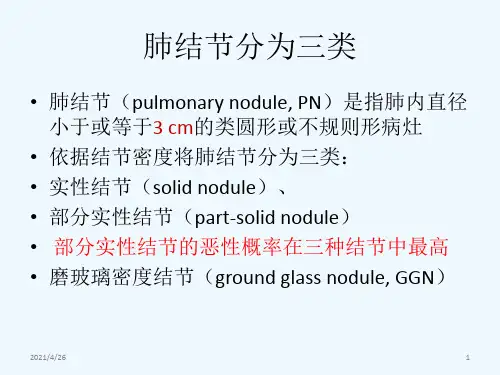
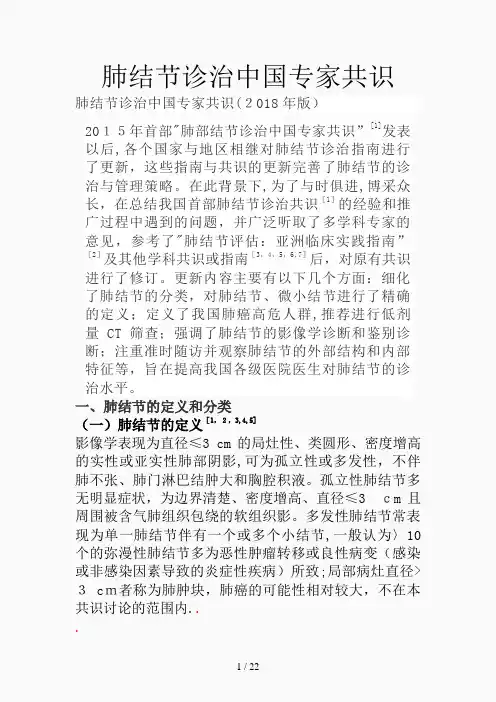
肺结节诊治中国专家共识肺结节诊治中国专家共识(2018年版)2015年首部"肺部结节诊治中国专家共识”[1]发表以后,各个国家与地区相继对肺结节诊治指南进行了更新,这些指南与共识的更新完善了肺结节的诊治与管理策略。
在此背景下,为了与时俱进,博采众长,在总结我国首部肺结节诊治共识[1]的经验和推广过程中遇到的问题,并广泛听取了多学科专家的意见,参考了"肺结节评估:亚洲临床实践指南”[2]及其他学科共识或指南[3,4,5,6,7]后,对原有共识进行了修订。
更新内容主要有以下几个方面:细化了肺结节的分类,对肺结节、微小结节进行了精确的定义;定义了我国肺癌高危人群,推荐进行低剂量CT筛查;强调了肺结节的影像学诊断和鉴别诊断;注重准时随访并观察肺结节的外部结构和内部特征等,旨在提高我国各级医院医生对肺结节的诊治水平。
一、肺结节的定义和分类(一)肺结节的定义[1,2,3,4,5]影像学表现为直径≤3 cm的局灶性、类圆形、密度增高的实性或亚实性肺部阴影,可为孤立性或多发性,不伴肺不张、肺门淋巴结肿大和胸腔积液。
孤立性肺结节多无明显症状,为边界清楚、密度增高、直径≤3cm且周围被含气肺组织包绕的软组织影。
多发性肺结节常表现为单一肺结节伴有一个或多个小结节,一般认为〉10个的弥漫性肺结节多为恶性肿瘤转移或良性病变(感染或非感染因素导致的炎症性疾病)所致;局部病灶直径>3 cm者称为肺肿块,肺癌的可能性相对较大,不在本共识讨论的范围内...(二)分类[1,2,3,4,5]1.数量分类:单个病灶定义为孤立性,2个及以上的病灶定义为多发性。
2.病灶大小分类:为便于更好地指导分级诊疗工作,对肺结节患者进行精准管理,特别将肺结节中直径<5mm者定义为微小结节,直径为5~10 mm者定义为小结节.微小结节可在基层医院管理;小结节可在有诊治经验的医院,如中国肺癌防治联盟肺结节诊治分中心管理;10~30 mm的肺结节则应尽早请有经验的专家诊治。

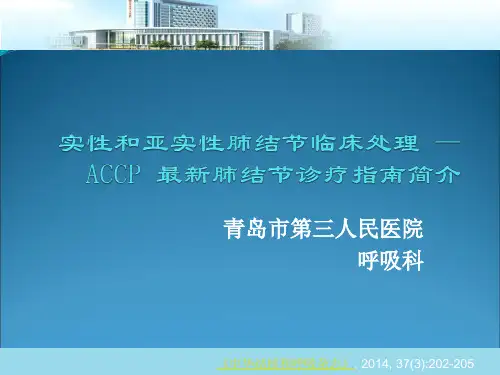
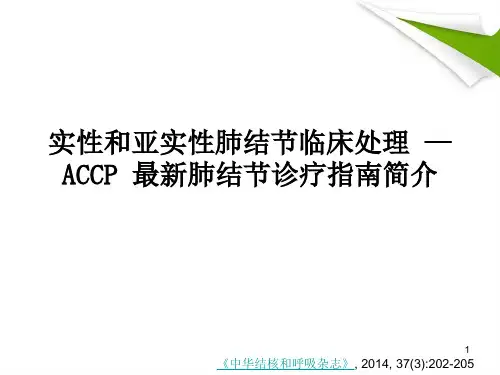



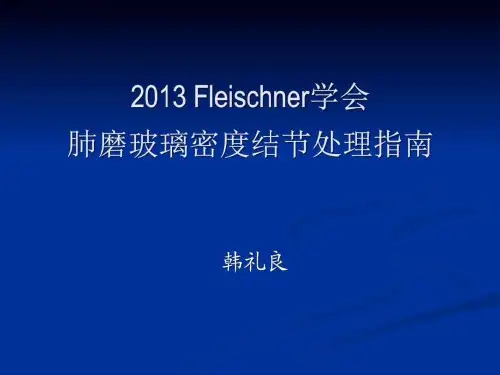
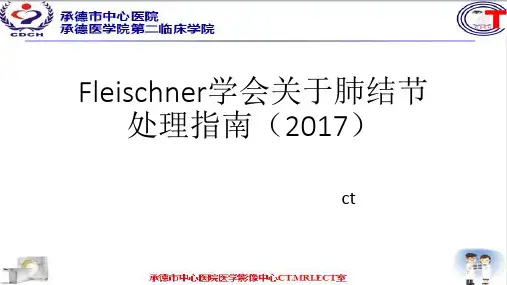
肺结节处理指南的解读和比较英文回答:Interpretation and Comparison of Guidelines for the Management of Pulmonary Nodules.Pulmonary nodules are small round or oval-shaped growths in the lungs that are often detected incidentally during medical imaging tests. The management of pulmonary nodules is a complex process, as these nodules can be benign or malignant. To guide physicians in making appropriate decisions for the management of pulmonary nodules, various guidelines have been developed. In this article, we will discuss the interpretation and comparison of these guidelines.One widely recognized guideline is the Fleischner Society guidelines. These guidelines provide recommendations for the management of incidental pulmonary nodules detected on CT scans. The guidelines take intoconsideration the size and appearance of the nodules, as well as the patient's risk factors for lung cancer. The recommendations include follow-up imaging, biopsy, or surgical resection depending on the characteristics of the nodules.Another important guideline is the American College of Chest Physicians (ACCP) guidelines. These guidelines provide a comprehensive approach to the management of pulmonary nodules, including recommendations for initial evaluation, surveillance, and treatment. The ACCP guidelines also consider the size, appearance, and patient characteristics when making management decisions. They provide algorithms that help physicians determine the appropriate course of action based on these factors.When comparing the Fleischner Society guidelines and the ACCP guidelines, there are some similarities and differences. Both guidelines recognize the importance of considering the size and appearance of the nodules in decision-making. However, the Fleischner Society guidelines focus more on follow-up imaging and less on invasiveprocedures, while the ACCP guidelines provide more detailed recommendations for surveillance and treatment options.It is important to note that guidelines are constantly evolving as new evidence emerges. For example, the British Thoracic Society (BTS) guidelines were recently updated to reflect new evidence on the management of pulmonary nodules. These guidelines emphasize the importance of a multidisciplinary approach and provide recommendations for the use of advanced imaging techniques, such as PET-CT, in the evaluation of nodules.In conclusion, the management of pulmonary nodules is a complex process that requires careful consideration of various factors. The Fleischner Society guidelines and the ACCP guidelines are two widely recognized guidelines that provide recommendations for the management of pulmonary nodules. While there are similarities between these guidelines, there are also some differences in their approach. It is important for physicians to stay updatedwith the latest guidelines and evidence to provide the best possible care for patients with pulmonary nodules.中文回答:肺结节处理指南的解读和比较。